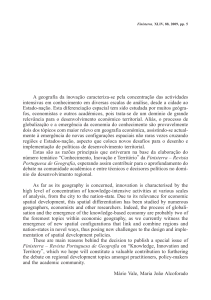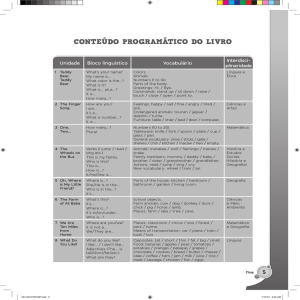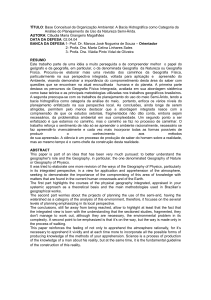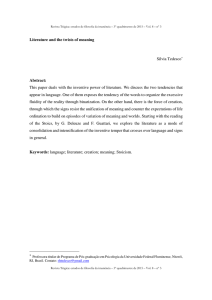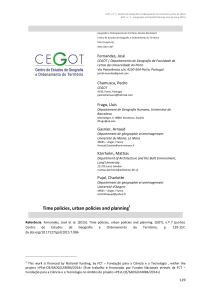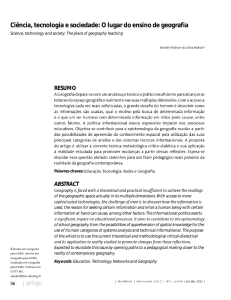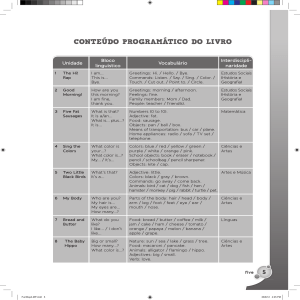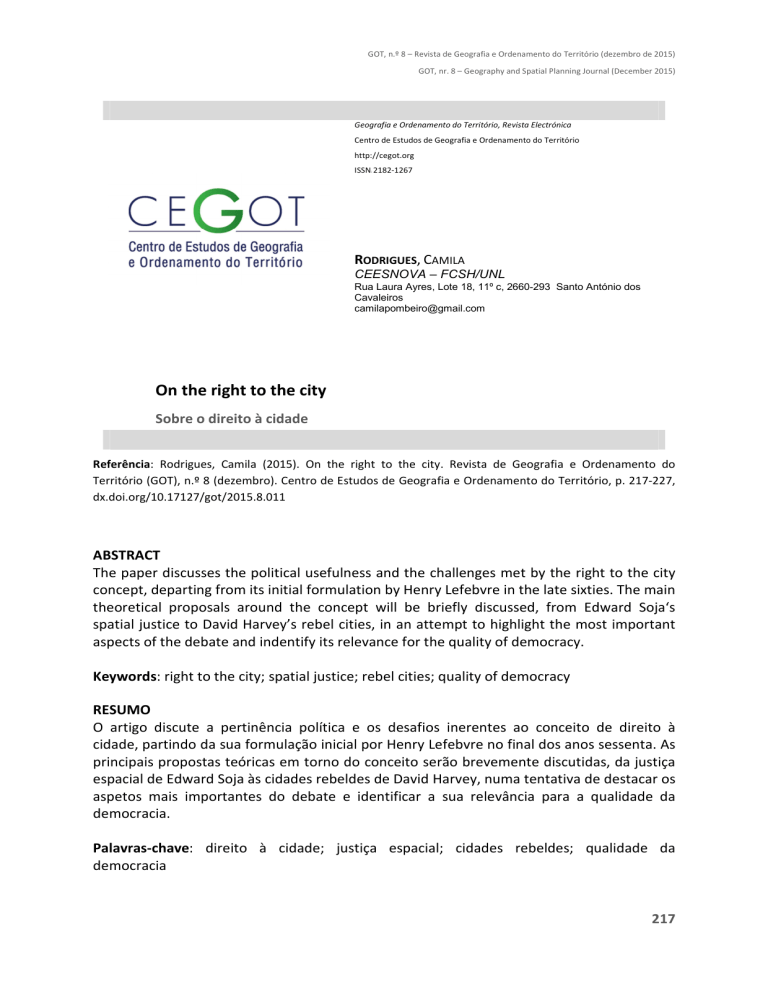
GOT, n.º 8 – Revista de Geografia e Ordenamento do Território (dezembro de 2015)
GOT, nr. 8 – Geography and Spatial Planning Journal (December 2015)
Geografia e Ordenamento do Território, Revista Electrónica
Centro de Estudos de Geografia e Ordenamento do Território
http://cegot.org
ISSN: 2182-1267
RODRIGUES, CAMILA
CEESNOVA – FCSH/UNL
Rua Laura Ayres, Lote 18, 11º c, 2660-293 Santo António dos
Cavaleiros
[email protected]
On the right to the city
Sobre o direito à cidade
Referência: Rodrigues, Camila (2015). On the right to the city. Revista de Geografia e Ordenamento do
Território (GOT), n.º 8 (dezembro). Centro de Estudos de Geografia e Ordenamento do Território, p. 217-227,
dx.doi.org/10.17127/got/2015.8.011
ABSTRACT
The paper discusses the political usefulness and the challenges met by the right to the city
concept, departing from its initial formulation by Henry Lefebvre in the late sixties. The main
theoretical proposals around the concept will be briefly discussed, from Edward Soja‘s
spatial justice to David Harvey’s rebel cities, in an attempt to highlight the most important
aspects of the debate and indentify its relevance for the quality of democracy.
Keywords: right to the city; spatial justice; rebel cities; quality of democracy
RESUMO
O artigo discute a pertinência política e os desafios inerentes ao conceito de direito à
cidade, partindo da sua formulação inicial por Henry Lefebvre no final dos anos sessenta. As
principais propostas teóricas em torno do conceito serão brevemente discutidas, da justiça
espacial de Edward Soja às cidades rebeldes de David Harvey, numa tentativa de destacar os
aspetos mais importantes do debate e identificar a sua relevância para a qualidade da
democracia.
Palavras-chave: direito à cidade; justiça espacial; cidades rebeldes; qualidade da
democracia
217
GOT, n.º 8 – Revista de Geografia e Ordenamento do Território (dezembro de 2015)
GOT, nr. 8 – Geography and Spatial Planning Journal (December 2015)
1. Lefebvre
In the heat of the late 60ties, Lefebvre (2012) departed from the effects of industrialization
on urban society to present the concept of the right to the city, hence initiating a lasting
theoretical discussion that maintains its vitality. Industrialization is understood as a
disrupting process that requires the breach of the pre-existing urban system, thus producing
a clash between the urban and the industrial realities. The crisis of the city emerges from
the reconfiguration of the urban system around the demands of the industrialization
process, which in an initial moment triggers the «explosion» of the traditional city.
Subsequently, the urban society develops on the ruins of the ancient city that is no longer
the passive receptacle of industrialization. Those who detain information, culture and power
retain the capacity of deciding on the urbanization process trough the exploitation of labour
entailed in the industrial production.
Throughout the nineteenth century an urban democracy could have risen, but since it
threatened the privileges of the new ruling class, it was prevented from being born by the
expulsion of the proletariat from the city centre and from the city itself. The working class
suffers the segregating consequences of the explosion of ancient urban morphologies. The
old proletarian misery is attenuated and tends to disappear in the large industrial countries
but a new poverty emerges, a misery of the habitat that affects all those expelled from the
centres to the outskirts and thus become deprived of the city. In these difficult conditions
arise the rights that define civilization, the right to work, education, health, housing. Among
these entitlements is the right to the city, understood as the right to a urban life translated
in the full use of times and locations. For the working class this right has a particular value
but it also represents the general interests of civilization and the particular interests of all
social strata of people for whom integration and participation matter.
The urban reform envisioned by Lefebvre has a revolutionary range since it gives way to a
strategy which opposes the strategy of the currently ruling class. It entails a revolutionary
transformation of society necessarily planned by the working class and its political
representatives that will result in socialism. The proletariat is the one who can destroy the
ideology of consumption and produce a distinctive new liberal humanism, the humanism of
218
GOT, n.º 8 – Revista de Geografia e Ordenamento do Território (dezembro de 2015)
GOT, nr. 8 – Geography and Spatial Planning Journal (December 2015)
the urban man whose implementation will require three types of revolution: economic
(reorientation of urban planning for social needs); political (democratic control of the state
and self-management) and cultural. As Marcuse (2014) points out, Lefebvre makes a moral
claim for social justice sustained in the highest human values. The metaphoric city
represents a new way of life for the urban society in general and its realization demands for
a deep reconfiguration of the power structures behind urbanization.
2. Travelling with the concept
Beyond its metaphoric understanding, the right to the city is a broad concept that requires
further clarification on which rights it entails and who will benefit from them. It can be
regarded as an exclusive right for the most dispossessed – the homeless, ethnic minorities,
people in a situation of poverty - thus entailing a positive discrimination dimension aimed at
contradicting the inequalities produced by the capitalist system; or it can be understood as
an inclusive right ascribed to all those who live in the city and desire to accede its resources
and opportunities to satisfy their needs and aspirations. But a right to what, specifically? A
right to housing, to transportation, to resources, to common goods, to define the way the
urban space is organized, or all those combined? And what if these various rights - and all
those who believe themselves entitled to them - conflict with each other? Who and what
takes precedence?
The multidimensionality of the concept entails a conflicting dimension that complexifies it
and as such it can hardly be regarded as a single uniform entity that is there to be enjoyed
equally by all. Attoh (2011) argues that second generation socio-economic rights that
pertain to the right to the city are potentially incompatible to the extent that their
promotion implies costs that demand for the sacrifice of some for the others. Besides, while
an individual or a group acquire the right to occupy, design or define the public space,
others are denied that same right as long as their goals and interests are not compatible,
which often happens in a complex urban society, where different cultures, religions and
races coexist in anonymity and rapidly interact with each other. A society that extends more
219
GOT, n.º 8 – Revista de Geografia e Ordenamento do Território (dezembro de 2015)
GOT, nr. 8 – Geography and Spatial Planning Journal (December 2015)
and more into the countryside, as the metropolis extends and embraces new territories,
fading the boundaries that once limited it. On the other hand, if individuals or groups have
the right to enjoy their way of life autonomously, without state interference, others may
feel disregarded or offended. A good example of this is the way the city deals with its Roma
inhabitants, which maintain specificities that are often seen as inadequate by the general
population, leading to the classical conflict minority versus majority.
To determine which rights to the city should be granted to whom it is necessary to situate
that same city in its democratic context and so obtain the necessary background in terms of
intended goals. If the quality of the democratic system is at stake, then the right to the city
must be conceived in order to enhance it as much as possible. However, the matter of the
quality of democracy is a complex one and it can be understood and measured differently.
For instance, it may depend on its contribution to individual freedom, regarded in terms of
autonomy achieved through resources, institutions, deliberating arenas and reason (Ringen,
2011), or it can be related with institutional characteristics like consensus democracy
(Lijphart, 2011).
Taking on Dahl’s (1973) definition, democracy is a political system characterized by the
quality of being completely or almost completely responsive to all its citizens. At the city
level, it would involve civic control over urban planning policies, which implies its
orientation towards the public interest in opposition to its orientation towards the interests
of particular groups. But then again, the capitalist society produces inequalities and those
who have more economical resources have a wider range of choice on where and how they
want to live. Land, equipments and services are there to be bought by those who can afford
them and the less well-off inhabitants have to settle for less. It is also possible that networks
of influence with local and national authorities may privilege the interests of some
individuals and groups over the others, thus disturbing the so desired urban civic control.
Considering the facts, the right to the city can be viewed as a way to correct the inequalities
of the capitalist system. This means that it must be enjoyed differently by diverse individuals
and groups: to contradict the dominance of some, it must favour the others. In a more
radical perspective, like Lefebvre suggests, it should entail an alteration of the political
system itself, away from capitalism and into socialism. Only then inequalities would be
220
GOT, n.º 8 – Revista de Geografia e Ordenamento do Território (dezembro de 2015)
GOT, nr. 8 – Geography and Spatial Planning Journal (December 2015)
corrected at their origin. The right to the city can thus be viewed as a stepping stone into
socialism, or a palliative for capitalism.
3. Spatial Justice
Whatever the approach to the right to the city – revolutionary or reformist – to situate it in
the democratic context implies some notion of social justice, insofar as it constitutes a
dimension of the quality of democracy that can be furthered through a spatial approach,
thus leading to the much debated concept of spatial justice. As we have seen, the right to
the city may discriminate positively its most dispossessed and disadvantaged inhabitants, so
that the city becomes more responsive to all its inhabitants: it can correct inequalities and
as such promote social justice. Soja (2009) regards spatial justice as more than just a
category included in the wider concept of social justice, it is a central concept in itself since
it emphasizes the impact of the geographical dimension in the production and reproduction
of (in)justice. Spatial discrimination is generated by the biases imposed on certain
populations due to their geographical location and it is critical in the production of spatial
injustice by the creation of long lasting spatial structures of privilege.
In this perspective, the political organization of the space in a capitalist society often leads
to an unequal and discriminatory distribution of the results of urbanization that can be
contradicted by a fair and balanced distribution in space of socially valued resources and the
opportunity to use them. There is a dialectic relation between the spatial and social
dimensions that reciprocally influence each other: if the space is socially produced then it
can be socially modified. The space is conceived as an active force that influences the
human existence at various levels - economical, artistic, environmental, social. To adopt a
spatial approach to justice enlarges the theoretical understanding of the causal factors that
determine it. To combine the terms spatial and justice opens a new range of possibilities for
political and social action, as well as social theorizing and empirical analysis, that would not
be so incentivized if the two terms were not used together.
221
GOT, n.º 8 – Revista de Geografia e Ordenamento do Território (dezembro de 2015)
GOT, nr. 8 – Geography and Spatial Planning Journal (December 2015)
For Marcuse (2014) the right to the city is regarded as a common cause that mobilizes
alienated social groups in the rejection of profit for other forms of solidarity and as such it
should aim for the deprived, exploited, impoverished, discontent. The spatial dimension
emerges as just one of many causes that contribute to worsen the city's problems, whose
origins are structural and lie in wider societal arenas. The spatial question is therefore
essentially derivative and must be integrated in a wider social context, but on the other
hand social injustices also have a spatial dimension. Spatial injustice is essentially due to the
involuntary confinement of alienated groups and to an unequal distribution in space of
resources. Its correction depends on the alteration of historically situated social, political
and economical conditions, since spatial remedies are necessary but not enough to
contradict injustice in the city.
4. The rebel way
In a neomarxist perspective, Harvey (2012) views capitalism as a feral monopolistic,
predatory and standardizing system that must be challenged in the city, taken in a broad
sense, which bursts with social inequalities but also with revolutionary potential. The
traditional proletariat is obsolete in contemporary occidental society and the rallying cry of
the disposed emerges in new and dynamic urban social groups, such as the occupy
movement in New York, strongly repressed by the capitalist forces who fully understand the
threat it represents.
These heterogeneous groups are not concentrated in factories and their dispersive nature
places organizational challenges to the traditional left, that must overcome its reluctance in
accepting a new reality and consequently merge the new social movements with classist
work based organizations. Left wing parties and syndicates must join efforts with locally
based transversal forces that gather different groups from several sectors in a common
struggle, thus constituting a new political force in the city, a city-wide anti-capitalist
movement capable of organizing production, distribution and consumption for the benefit
of all the people, instead of privileging just a few. Such a coalition would demand for a joint
222
GOT, n.º 8 – Revista de Geografia e Ordenamento do Território (dezembro de 2015)
GOT, nr. 8 – Geography and Spatial Planning Journal (December 2015)
effort from the forces of culture and political radical tradition, which must mobilize citizens
beyond class interests.
For several realities there are various possible strategies and it is possible for the capitalist
structure to be challenged from within without a revolutionary transition. However, it is
demanding for alternative organizations, such as associations and cooperatives, to maintain
their integrity in a competitive capitalist system that entails exploitation practices. On the
other hand, to create an isolated socialist city in a capitalist environment would certainly
generate intense repression. As an alternative, some cities, such as Porto Alegre, have
managed to implement transforming democratizing measures, as the participative budget,
that can contribute to deepen urban democracy without generating much opposition and
can be exported to other contexts.
Nevertheless, according to Harvey, the consolidation of urban rebellions demands for
intervention at a higher level of global coordination, the level of the system that embeds all
states. Otherwise, state level reformism will simply reconstitute neoliberalism. Urban
networks are crucial in such a movement, networks that are democratic, egalitarian and
solidarious in their struggle against class dominated capitalism. In his view, the starting
point for the revolutionary process resides then in the reinvention and reorganization of
cities for anti-capitalist struggle, which implies alternative forms of urbanization, that
remains a mean for the absorption of capital and labour surpluses in a highly speculative
capitalist environment.
5. Use or abuse
As we have seen, the concept of the right to the city emerges as a response to injustices
perceived in the capitalist system. In a highly competitive and individualist environment
dominated by private property entitlements and free markets, the classic conflict liberty
versus equality is prompted by phenomena of exploitation and dispossession. An unequal
distribution in space of valued resources and the opportunity to use them deepens as
disparities in income increase and networks of privilege pull their strings in the backgrounds
223
GOT, n.º 8 – Revista de Geografia e Ordenamento do Território (dezembro de 2015)
GOT, nr. 8 – Geography and Spatial Planning Journal (December 2015)
of urbanization processes. The access to housing, equipments and infrastructures is
conditioned by one’s capacity to acquire them in the market, for they are scarce goods that
are not available to everyone. The neoliberal ideal of the self made deserving man that
conquers his rights by his own personal effort imposes itself more and more in
contemporary democracies. Using austerity as an argument, it justifies the withdrawal of
compensation mechanisms, such as the ones entailed in a redistributive social state, thus
reinforcing inequalities.
Alternatives are presented under the right to the city conceptualization, some revolutionary,
others reformist, but they all have in common the concern with a decline in democratic
quality that results from the decrease of civic control over urbanization processes. Harvey’s
radical cry for revolutionary action generates controversy given its strong connection to a
Marxist theoretical approach that may be regarded as obsolete. Such is the understanding
of Souza (2010), which criticizes Harvey for his attachment to what he regards as a
reductionist, centralistic and prejudiced Marxism that undermines his understanding of the
complexity of contemporary social movements, which are wrongfully accused of being so
involved in local action that they fail to see the big picture. From a left libertarian point of
view, Sousa deplores Harvey’s attachment to hierarchies and refuses any pretention to a
socialist state. Instead, he proposes free association and horizontal networks as strategies
against oppression by class exploitation, but also by a centralized, hierarchical state. In this
perspective, institutional struggle is just a supplement for a broader direct action that
demands for a pragmatic relation with the state, therefore preventing appropriation and
sectarianism.
As Lefebvre recognized, the political utility of the right to the city concept depends on its
usefulness as a tool that assists us in experimenting with reality. Whatever the perspective –
revolutionary or reformist; vertical or horizontal - the right to the city, both in its theoretical
assumption and as a rallying cry for urban social movements, is challenged by the risk of
trivialization of Lefebvre’s initial concept. Once it is appropriated by a large spectrum of
actors, from local to national authorities, from NGOs to social movements, it may become
detached from its original meaning, a common phenomenon that affects man concepts,
including the one of democracy. Another concern resides in the particularism of the actors
224
GOT, n.º 8 – Revista de Geografia e Ordenamento do Território (dezembro de 2015)
GOT, nr. 8 – Geography and Spatial Planning Journal (December 2015)
who mobilize for this right. One of the main challenges to the right to the city is the extent
to which social actors can move beyond their own interests and embrace a common global
struggle that can effectively produce a better democracy for all. Finally, there remains a risk
of cooptation by actors who intent to «domesticate» the concept, thus neutralizing its
transformative potential. As «The Leopard» well taught us, sometimes «something has to
change, so that everything remains the same».
But the challenges to the right to the city are yet not exhausted. Another fundamental
aspect to consider is the applicability of the concept to different geographies, for concepts
drafted in the western academia naturally reflect a very specific understanding of reality
that emerges in emblematic contexts, which cannot be simply extrapolated to other
scenarios without considering particular causal relations. Paris and Chicago are not Cairo or
Mumbai, so to which point a conceptual framework drafted considering one can be applied
to the other is a pertinent matter to bear in mind.
Ananya Roy (2009) challenges researchers to rethink their list of big cities and to look
beyond generalist and prejudiced assumptions of third world underdeveloped urban
realities that must be regulated and corrected under the framework of the western ideal
model. She boldly suggests dislocating the western centre of theoretical production to the
global south in order to generate alternative analytical readings and thus overcome current
epistemological limits. Concepts are geographically grounded and may be more or less
susceptible to generalization, but opening up the geographies in which they are produced
enriches the theoretical universe available to any researcher in search of the most adequate
conceptual tools.
Cities like Lisbon, Oporto or Setubal, who are in the periphery of the centre, face the risk of
remaining virtually unnoticed unless they also reclaim their analytical territory, thus
becoming active contributors to knowledge production on the metropolis.
Portugal
provides an interesting case study. It inaugurated the third wave of democratic transitions
with a revolutionary transition to democracy in the mid seventies, which was followed by an
intense migratory flow from the former colonies. Prior to that, from the mid twentieth
century, people from all over the countryside had been moving to the main city areas in
search for work opportunities in the industrial sector. Unable to access the housing market
225
GOT, n.º 8 – Revista de Geografia e Ordenamento do Território (dezembro de 2015)
GOT, nr. 8 – Geography and Spatial Planning Journal (December 2015)
with their meagre wages, they resorted to numerous shanty towns to which the authorities
turned a blind eye. When the April 1974 revolution arose, about 25% of the population
living in continental Portugal resided in homes deprived of any criteria of privacy, safety and
comfort. In about two and a half million households, 67% had no toilet facilities, 60% were
not served by the sewerage system, 53% had no electricity and 52% had no water supply.
The housing shortage was estimated at about 600 000 households (Bandeirinha, 2007: 68).
All these fluxes of people and housing shortages had to be managed and accommodated.
During the revolutionary period intense popular movements arose around the right to
housing and innovative responses emerged, such as the Ambulatory Local Service (SAAL),
which comprised an intense participatory approach. These experiences provide interesting
case studies and can certainly raise pertinent concerns and contribute to the theoretical
debate around the right to the city, which remains a useful concept to analyze capitalist
urbanization as long as the concerns identified are properly considered and adjusted to the
national reality. More ambitiously, it can constitute a starting point from which new
concepts, practices and ideas can be forget and generalized, so that scholars and
practitioners in other geographies may profit from the Portuguese experience.
6. References
ATTOH, Kafui. What kind of right is the right to the city? Progress in Human Geography. Sage. 2011. pp.669685.
BANDEIRINHA, José António. O Processo SAAL e a arquitectura no 25 de Abril de 1974. Coimbra: Imprensa da
Universidade. 2007. 978-972-8704-76-6.
DAHL, Robert. Polyarchy – participation and opposition. Yale: Yale University Press, 1973.
HARVEY, David. Rebel Cities – from the right to the city to the urban revolution. Londres – Nova Iorque: Verso,
2012. 978-1-84467-882-2.
LEFEBVRE, Henry. Le Droit à la Ville. Paris: Anthropos Economica, 2009. 978-2-7178-5708-5.
LIJPHART, Arend. Smposium Measuring Democracy. Vol.48. Springer, 2011. pp. 17-18.
MARCUSE, Peter. Reading the right to the city. City: analysis of urban trends, culture, theory, policy, action. vol.
18(1). Londres: Routledge, 2014. pp. 4-9.
RINGEN, Stein. The Measurement of Democracy – towards a new paradigm. Simposium Measuring Democracy.
Vol.48. Springer, 2011. pp. 12-16.
st
ROY, Ananya. The 21 Century Metropolis: new geographies of theory. Regional Studies. 43:6. pp-819-830.
226
GOT, n.º 8 – Revista de Geografia e Ordenamento do Território (dezembro de 2015)
GOT, nr. 8 – Geography and Spatial Planning Journal (December 2015)
SOJA, Edward. The city and spatial justice. Spatial Justice/Justice Spatiale. Nº. 1, September 2009.
SOUSA, Marcelo. Which right to which city? In defence of political-strategic clarity. Interface. Vol.2(1). Kildare:
National University of Ireland, Department of Sociology, 2010. pp.315-333.
227

